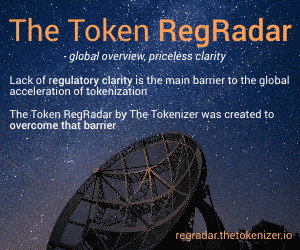The first STO milestone is German: Bitbond issues the first BaFin approved security token bond
Finally it happened: a German company has won the race to issue a fully regulated security token, at least in Europe. Despite others having claimed to have “tokenized” something in the past, this Bitbond issue is a radical shift in the STO narrative so far.
By Andrea Bianconi
Indeed Bitbond — a Berlin-based crowdfunding company — has released a prospectus approved by German regulator BaFin to raise funds by issuing a security token bond on the Stellar blockchain, without a depositary bank, without certificates or coupons and intermediaries.
This is a big step forward, this is finally the game changer that I have been waiting for in the last 12 months.
If anything, my bet would have been on a smaller and more flexible jurisdiction to be able to finalize this first (such as Switzerland for instance).
The German move is therefore important for the industry. It sends a clear signal that Germany is now leading the STO race and is ready to take your business. At least among conservative German medium sized company owners — who in my experience are very much keen in “keeping base safe at home” — this basically means “hey guys, why take your business elsewhere? Take no risks and look no further, you can now conveniently raise funds through STOs at home”.
And with the uncertainties of Brexit — which may penalize London’s financial hub in the short term — the Germans might even be able to attract potential STOs from other EU countries. In the
Now, as promised here, I have thoroughly gone through Bitbond’s prospectus and I also exchanged e-mails with the company’s General Counsel — Henning Franken — to clarify some points. The following is my analysis of Bitbond´s STO bond issue.
1. Bitbond’s Business background
Bitbond’s platform brokers loans between investors and small business owners. Through its fully owned subsidiary Bitbond Finance GmbH, they aim to raise capital to directly finance small business owners through the Bitbond platform.
2. Bitbond’s — Security Token Offering (STO)
In order to raise capital Bitbond Finance will issue a security token bond with a hard cap of €100M. The currency of issue is the Euro, although investors can also pay the principal amount in crypto.
The company will issue BB1 tokens having nominal value of €1 and representing a debt instrument (Bond) paying an annual interest of 4%, payable in quarterly instalments. In addition, it will pay a variable interest amount equivalent to 60% of the profits realized by Bitbond GmbH in its business activities (if any). The BB1 tokens will be issued on the Stellar blockchain. The duration of the bond is 10 years.
For obvious practical reasons, the contractual assignment of token rights or their pledge — otherwise possible with standard securities under civil contract law — are negated in this case (art. 7.2.8 limited prohibition of assignment). This is because the transfer of rights to the token must be allowed only if done through the Stellar blockchain, which enables the sale and transfer of the full ownership of the token and not ancillary rights. Therefore the investor acknowledges with the prospectus to substantially refrain from pledging or otherwise assign the rights to the tokens outside of the Stellar blockchain. This is necessary to avoid a conflict between what would be legally possible under civil contract law and what is practically feasible with the blockchain.
3. Comparing the token-Bond vs a traditional bond
3.1 Costs
First of all the issuance direct costs are a fraction of those with a comparable traditional bond. The biggest direct cost is for marketing and sales at around € 400.000, then € 120.000 for legal and prospectus and € 80.000 for software development. A mere 0,6% direct costs if the bond is fully subscribed, excluding all indirect costs such as commissions for tips, referrals and rewards for affiliates.
3.2 No Intermediaries
Then there are no financial intermediaries to deal with, and no commission/premium/agio will be paid by the subscribers. The issuance is direct to the investor and the BB1 tokens will be allocated via Smart Contract directly to the Stellar wallet of the investor.
3.3 Potential for Liquidity
The liquidity is still an issue to be verified since there is no real market for trading such tokenized bonds. So it remains to be seen both how much of the €100M will be subscribed and then how liquid the BB1 tokens will be and which market will be chosen by the issuer for trading them.
Anyway, the potential advantages are there and liquidity will gradually improve with the growth of the sector and the involvement of traditional financial players. I have no doubt that financial operators, while being “disintermediated” on the token-bond issuance phase, will carve themselves an active and profitable role in trading those tokens and thereby will bring liquidity to the markets (market-makers will come). Besides, traditional financial instruments such as commercial papers or small corporate bonds are also highly illiquid. Here we have at least the potential to create a global blockchain based market where those securities can be traded. It will all come, with time.
3.4 Programmability
Another advantage is the programmability of the tokens via Smart Contracts. In this particular case a script is programmed that executes automatically all the steps relating to the payments of interests and redemptions, as well as the calculation of the exchange rate and of the amounts due and the allocations to the wallets. The script however is activated manually by the issuer, so in the end it is semi-automated.
4. Risks
The risks are properly set out in the prospectus. I wish however to dig in more deeply and examine more attentively some of the risks. Leaving aside the clear risks which are common to any business and to any investment in financial instruments, I’d like to focus on those risks which are more opaque and intrinsic to the business of crypto lending.
4.1 ERP Loans and exchange rate risks
When Bitbond lends crypto to small businesses via its platform it enters into
4.2 EURT risk
To do so Bitbond has partnered with platforms (such as Tempo) to covert fiat into a digital stable-coin backed up with Euros 1:1 which is called EURT (Euro Token).
According to Henning Franken — Bitbond’s General Counsel — “Tempo emits
Compared to the model described above (4.1) the exposure is even further reduced since every fiat Euro transferred to Tempo gets exchanged to one Euro-Token which keeps its value of 1 Euro at any time of the transaction. This way there is even between transfer to the borrower and exchange no exposure to fluctuation anymore. Furthermore the transactions are faster, less cost intensive and more secure.
Bitbond has introduced the latter model to all German and most of its European customers and will continue to do so in 2019 and further.
Bitbond Finance GmbH (the emitter of BB1) will probably invest the BB1 funds mostly in German and EEA-loans because the majority of our existing customer base is located there”.
By the way — on that same issue — it is worth noting that JP Morgan has recently announced that it will start issuing its own stable JP Coin pegged to the US$. It will be used initially for internal operations but the way forward here is clear. When large financial institutions get involved, then any third party risk related to the issuer of the pegged-coin (such as this third party solvency) can be at least mitigated and properly rated, even more so if the counterparty of your fiat-pegged-coin is JP Morgan or Goldman Sachs instead of any small start-up. This is certainly important to allow the investment of institutional moneys.
4.3. Repayment of principal (Redemption at maturity) and interest payments
All the interest payments, as well as the redemption of the BB1 tokens at maturity, will be made exclusively in XLM. This means that the euro sum due will be converted at the moment of payment into the corresponding quantity of XLM which will be transferred to the wallet of the investor. The investor therefore bears the same exchange rate risk described under 4.1 above until XLM are again converted into fiat.
An alternative mechanism to the repayment in XLM of principal and interest is not indicated by Bitbond. Also it is not clear why EURT will not be used in this case to repay interest and principal. My point is that XLM is not exactly the US$. What if in a few years it does not exist anymore? At least a general purpose clause to establish an alternative payment mechanism in fiat currencies or a fiat-pegged-coin could have been inserted.
There is another risk to consider though which is not so apparent. XLM market capitalization at the date of writing is a mere 1,6bn US$ equivalent, not exactly in the league with BTC (67bn US$). Therefore price manipulations cannot be excluded. If the XLM price is artificially inflated ahead of key payment or redemption dates, less XLM will be paid out to the investor who bears the exchange rate risk until XLM are converted into fiat.
In addition, the investor cannot be guaranteed adequate XLM liquidity and its convertibility into BTC/ETH or fiat. In other words the investor carries an “exit” risk with such cryptocurrency. This is important.
4.4 Coding errors and lack of dispute resolution mechanism
Another issue is the lack of a dispute resolution mechanism. Due to the still experimental nature of tokenizations and the technical risks that comes with it — think about a bug in the code or a mistaken token or payment transfer which is irreversible on the blockchain — I would have appreciated an arbitration procedure to allow investors to quickly settle those issues.
Fair to say that Bitbond duly acknowledges those risks in art. 2.2.14 and thoroughly explains the way the semi-automated payments are executed, but it fails to indicate the solution in case of failure. German law regulates the BB1 issue with the non-exclusive jurisdiction of the Berlin Court.
5. Reactions
Strangely enough, what is the biggest achievement for the securities token industry so far, has gone almost unnoticed by the largest international crypto media. Some have reported the news but no real comments. Though the news have clearly made the headlines among the specialized German media, this is by no means a local achievement. It is a global success for the industry.
Therefore I have asked a prominent German crypto expert, to share with me his views.

Oliver Krause — my colleague at Untitled-INC — comments: “it is clearly a milestone that has been achieved here, although I see substantial potential for improvement of STOs from the investors perspective. I expect more maturity coming to
Conclusions
Notwithstanding Bitbond’s milestone achievement, it remains to be seen how this digital bond will be subscribed. My feeling is that the BB1 token bond will be very likely successful among crypto investors who may want to switch and hedge risky crypto positions and convert BTC/ETH or other cryptos into this bond. Crypto whales, miners and those who have accumulated fortunes in 2017 can easily oversubscribe this Bitbond.
Because this is really the first time that such a digital bond will be open to fiat investors it is difficult to predict how it will go. Objectively though — in a world of zero or negative rates, where even real estate yields less than 2% (in Germany at least), a 4% fixed yield plus a variable amount — is undoubtedly a valuable proposition for any investor.
Finally, regarding the involvement of institutional investors, I feel that until a market for hedging fiat-crypto exchange-rate risks is not developed — with liquid enough options and futures contracts — and a stable-coin backed up by a major financial institution is created (see the JP Coin), it will be hard to see institutional money flowing in.
But Rome was not built in a day and we are getting there much faster than it seems.
***
Legal Disclaimer: This paper is for general guidance only and it does not constitute legal advice. As such, it should not be used as a substitute for consultation with lawyers on specific issues. All information in this paper is provided “as is”, with no guarantee of completeness, accuracy, timeliness or warranty of any kind, express or implied.
Disclosures: I do not have any interest in the company Bitbond or in the offer which is the subject of this article, I did not know any of Bitbond’s people before writing this article and I have not been paid or otherwise hired by Bitbond for any services and I have not been promised any economical rewards or benefits for writing this piece, which is a totally independent piece of information about their offer.
Originally published at hackernoon.com on March 6, 2019.

at conferences and events. Founder and CFO of the Luxembourg based www.thinkblocktank.org, a member of the untitled-inc and an active contributor to the Berlin blockchainhub.net, and the German Blockchain Bundesverband Bundesblock.
https://www.bianconiandrea.com/
https://www.linkedin.com/in/andrea-bianconi-blockchain-law/
https://medium.com/@andreabianconi
http://thinkblocktank.org/
http://www.untitled-inc.com
You Might also Like





















